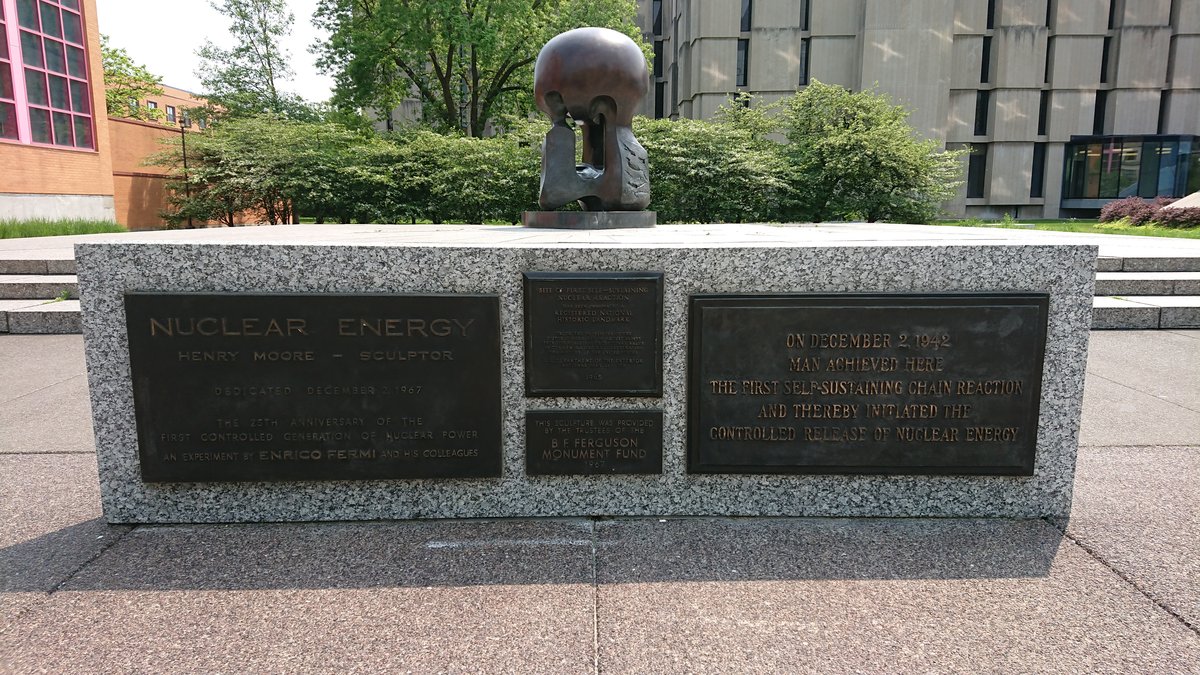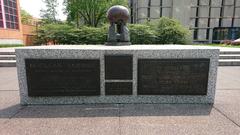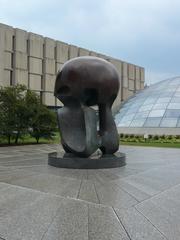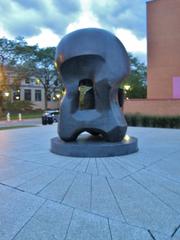
Nuclear Energy Chicago Visiting Hours, Tickets, and Historical Significance Guide
Date: 14/06/2025
Introduction: Chicago’s Pivotal Role in Nuclear History
Chicago is renowned as the birthplace of the Atomic Age, a distinction earned on December 2, 1942, when physicist Enrico Fermi and his team achieved the world’s first controlled, self-sustaining nuclear chain reaction beneath the west stands of Stagg Field at the University of Chicago. This monumental experiment, known as Chicago Pile-1 (CP-1), fundamentally transformed modern science, energy, and global geopolitics. The achievement is commemorated today by the striking Henry Moore “Nuclear Energy” sculpture, which stands as both a symbol and a prompt for reflection on the dual promise and peril of nuclear technology (news.uchicago.edu; chicago.suntimes.com; ahf.nuclearmuseum.org; Wikipedia).
For visitors, the CP-1 site and sculpture offer a unique opportunity to engage with one of the most consequential moments in scientific history. This guide provides comprehensive information about the historical context, visiting logistics, accessibility, nearby attractions, and practical tips for making the most of your experience.
Table of Contents
- Scientific and Historical Context
- Visiting the Chicago Pile-1 Site
- Nearby Nuclear and Scientific Sites
- Visitor Tips and Practical Information
- Frequently Asked Questions (FAQs)
- Conclusion and Visitor Recommendations
- References and Further Reading
Scientific and Historical Context
The Manhattan Project and Chicago Pile-1
The Manhattan Project, the United States’ clandestine effort to develop atomic weapons during World War II, found a critical hub at the University of Chicago. The Metallurgical Laboratory (“Met Lab”) was tasked with solving the immense challenge of achieving a self-sustaining nuclear chain reaction. After delays at a remote site, project leader Arthur Compton authorized construction of CP-1 beneath Stagg Field. The reactor, a massive stack of graphite blocks and uranium, was assembled in secrecy and without precedent (news.uchicago.edu; en.wikipedia.org).
The First Nuclear Chain Reaction
At 3:25 p.m. on December 2, 1942, Enrico Fermi and his team initiated the world’s first controlled, self-sustaining nuclear chain reaction. The experiment produced only about half a watt of energy—insufficient to power a light bulb—but it was proof of concept that nuclear fission could be controlled and harnessed (news.uchicago.edu). The coded message sent to Washington—“The Italian navigator has landed in the New World”—signaled a turning point in both science and world history (ahf.nuclearmuseum.org).
Aftermath and Legacy
Following the successful demonstration, CP-1 was dismantled and reassembled as CP-2 at Site A in Red Gate Woods, with improved safety measures. The original Stagg Field site was eventually replaced by the University’s Regenstein and Mansueto Libraries.
The impact of CP-1 reverberated globally:
- Nuclear Weaponry: The experiment was a crucial step toward the development of atomic bombs, which played a decisive role in ending WWII (news.uchicago.edu).
- Nuclear Energy: The technology paved the way for civilian nuclear power and advanced medical applications (ahf.nuclearmuseum.org).
- Scientific Awareness: The event inspired the Bulletin of the Atomic Scientists and the Doomsday Clock, raising public consciousness about nuclear risks (news.uchicago.edu).
Commemoration: The Henry Moore Sculpture
To commemorate the 25th anniversary, the University commissioned the British sculptor Henry Moore, whose “Nuclear Energy” sculpture was unveiled in 1967 at the original CP-1 site. The abstract bronze monument stands 12 feet tall, inviting multiple interpretations—some see a mushroom cloud, a human skull, or a cathedral dome, encapsulating the dual nature of nuclear technology (SAIC; Wikipedia). Nearby plaques memorialize the scientists involved and contextualize the achievement.
Visiting the Chicago Pile-1 Site
Location and Hours
- Address: Intersection of Ellis Avenue and 57th Street, University of Chicago, Hyde Park.
- Hours: Open year-round during daylight hours.
- Admission: Free; no tickets required.
The sculpture is outdoors in a granite-paved plaza, surrounded by interpretive plaques and landscaping. The area is easily accessible by public transit (CTA and Metra) and is pedestrian-friendly (Lonely Planet; Timeout Chicago).
Accessibility and Admission
- Wheelchair Access: The site features paved walkways and ramps.
- Safety: The area is safe and regularly monitored; there is no residual radioactivity (news.uchicago.edu).
- Visitor Amenities: Nearby university buildings offer restrooms, cafes, and seating.
Guided Tours and Events
While the site is self-guided, it is often included in campus walking tours and citywide history and architecture itineraries. Anniversaries and special events occasionally feature lectures and commemorative programs (SAIC).
Nearby Nuclear and Scientific Sites
Red Gate Woods (Site A/CP-2)
After the original experiment, the reactor was relocated to Red Gate Woods, part of the Cook County Forest Preserves. Visitors can explore hiking trails and view historical markers at the former reactor burial site. The area is open daily from sunrise to sunset, free of charge (Atomic Tourism).
Argonne National Laboratory
Located southwest of Chicago, Argonne National Laboratory conducts advanced nuclear research. Public tours are limited and require advance registration and security clearance (UChicago News; Argonne National Laboratory).
GTI Energy
In Des Plaines, IL, GTI Energy focuses on energy transition technologies and occasionally hosts public events. Contact them in advance for visitor information (GTI Energy Visitor Guide).
Visitor Tips and Practical Information
- Best Time to Visit: Spring, summer, and early fall for comfortable weather and ample daylight.
- Photography: The sculpture’s form is particularly striking during early morning or late afternoon light.
- Public Transit: Take the Metra Electric Line to 55th-56th-57th Street or CTA bus lines #2, #6, #15, #28.
- Parking: Metered street parking and university garages are available but may be limited during peak hours.
- Nearby Attractions: Museum of Science and Industry, Smart Museum of Art, Midway Plaisance, Hyde Park’s dining and shopping options.
- Accessibility: The campus and sculpture are wheelchair accessible; Red Gate Woods trails are natural and uneven.
Frequently Asked Questions (FAQs)
Q: Is there an admission fee or ticket required to visit the CP-1 site or Nuclear Energy sculpture?
A: No, both are free and open to the public year-round during daylight hours.
Q: Are guided tours available?
A: The University of Chicago and some local organizations offer guided tours; check their websites for schedules.
Q: Is the site wheelchair accessible?
A: Yes, paved walkways provide easy access.
Q: Can I take photographs?
A: Yes, photography is encouraged.
Q: Are there restroom or dining facilities nearby?
A: Yes, university buildings and nearby Hyde Park establishments offer facilities and food options.
Q: Is it safe to visit?
A: Yes, extensive testing has confirmed there is no residual radioactivity at the site (news.uchicago.edu).
Conclusion and Visitor Recommendations
Chicago Pile-1 and the Henry Moore “Nuclear Energy” sculpture offer an unparalleled window into the origins of nuclear science and its profound influence on the modern world. As a free, accessible, and thoughtfully interpreted site, it is ideal for history enthusiasts, science lovers, students, and travelers seeking meaningful cultural experiences. The surrounding Hyde Park neighborhood and University of Chicago campus provide a rich context for further exploration, from art museums to scenic parks and iconic architecture.
To deepen your understanding, consider participating in special programs, joining guided tours, or using audio guide apps such as Audiala. Respect the memorial’s significance and reflect on the enduring questions of scientific progress and responsibility.
For up-to-date visitor information, special events, and additional resources, consult the official University of Chicago visitor page, local tourism guides, and the recommended references below.
References and Further Reading
- Visiting Chicago Pile-1: History, Tickets, and Chicago’s Historic Nuclear Site, 2024, University of Chicago News (news.uchicago.edu)
- Nuclear Energy Sculpture in Chicago: Visiting Hours, Tickets, and Historical Significance, 2024, SAIC News (SAIC)
- Visiting Chicago’s Nuclear History: Chicago Pile-1 and the Henry Moore Nuclear Energy Sculpture, 2024, Mapping Nuclear Legacies (Mapping Nuclear Legacies)
- Visitor Information and Practical Tips, 2025, University of Chicago Visitor Resources (visit.uchicago.edu)
- Chicago Pile-1 - Wikipedia (Wikipedia)
- Nuclear Energy (sculpture) - Wikipedia (Wikipedia)
- American Physical Society Recognizes Chicago Pile at University of Chicago Historic Site, 2024, UChicago News (news.uchicago.edu)
- Oppenheimer, University of Chicago and Manhattan Project History, 2024, Chicago Sun-Times (chicago.suntimes.com)
- Historical Places in Chicago, Lonely Planet (Lonely Planet)
- Public Art in Chicago: Nuclear Energy Sculpture, Timeout Chicago (Timeout Chicago)
- Choose Chicago Visitor Guide (Choose Chicago)
































































































































































